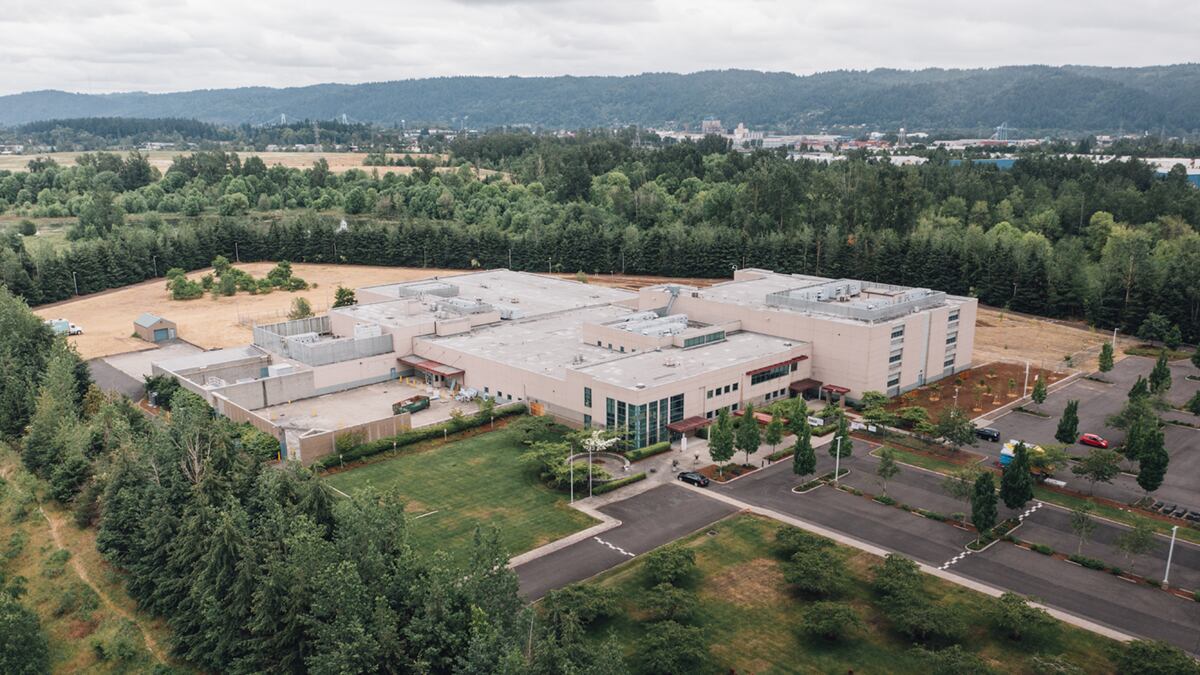For $250 a month, unhoused Portlanders who stay sober can get three meals a day and a curtained-off bed in a never-used jail in North Portland.
That building, once known as Wapato Jail and now called the Bybee Lakes Hope Center, has for the better part of a decade been at the center of a debate over how to address homelessness in Portland. Last October, it officially opened as an emergency shelter that offers long-term housing to people who maintain sobriety. It currently houses about 45 residents a night.
“They said it couldn’t be done. That’s what I like about it,” says Alan Evans, chief executive of Helping Hands Reentry Outreach Centers, the nonprofit that operates Bybee Lakes Hope Center.
But Evans isn’t the only person who believes in the shelter’s model. And the facility’s residents are not the only ones paying.
In April, the Oregon Legislature passed a bill that helped fund the former jail’s transformation with a $2 million investment. That’s a sizable cash infusion for a project that local officials, most notably Multnomah County Chair Deborah Kafoury, had long viewed with skepticism.
Bybee Lakes Hope Center has a well-placed ally: State Sen. Betsy Johnson (D-Scappoose), co-chair of the Joint Ways and Means Committee, secured the $2 million personally.
“Speaker [Tina] Kotek and I had a personal conversation about it,” Johnson tells WW. “We are trying to salvage taxpayer value out of a perfectly serviceable building that really has worn the test of time. After 20 years of no occupancy, that building remains remarkably intact structurally.”
The state investment, which has until now gone unreported by Portland-area news outlets, is notable because the county and state are now supporting strikingly different approaches to address homelessness.
Chair Kafoury and the Multnomah County Board of Commissioners sold the jail for $5 million in 2018, after rejecting pleas from business leaders to use it as a county-run shelter.
Kafoury toured the facility in early May—and, in the face of mounting homelessness, she sounds more equivocal.
“While it looks like it will work for some people, it also confirmed for me that selling the property was the right decision for the county,” she says. “But I appreciate that folks across the private sector continue to step up because it’s going to take all of us coming together to end homelessness in our community.”
The legislators who secured the $2 million did not get a financial analysis of the project, and the owner and operator did not provide information about operating costs to WW.
Johnson, who has a well-earned reputation as a fiscal conservative, says she didn’t need financial details to support the project. “We’re well aware of their financial situation,” Johnson says. “I’ve been watching Helping Hands perform in communities that I represent in the Legislature for 20 years.”
Indeed, Evans operates nearly a dozen shelters, many in Johnson’s coastal legislative district. Both Johnson and Sen. Elizabeth Steiner Hayward (D-Portland), her Ways and Means committee co-chair, sit on the Bybee Lakes Hope Center advisory board.
Thanks to the senators’ efforts, the state of Oregon now appears to be one of the largest investors in the shelter. That means the state and county will now fund what amounts to competing models for aiding the poorest, most vulnerable Portlanders.
Multnomah County has tried to send services where unhoused people are—to meet their physical needs as well as treat possible substance abuse and mental health concerns. Bybee Lakes takes a different approach: It requires sobriety and a monthly fee from individuals who wish to stay at the facility for more than four days and enroll in what’s called the reentry program. That’s an old-fashioned model—and one that Johnson vouches for.
“I can’t think of anything much more moving than watching grown men throw themselves into each other’s arms to celebrate sobriety and clean living,” Johnson says. “They kick drug habits, they don’t drink, they’ve got jobs. Helping Hands’ success rate is formidable.”

A recent tour of Bybee Lakes Hope Center showed improvisation—and a lot of deferred maintenance.
A woman flipped pancakes on an electric griddle in a classroom, which serves as a temporary cafeteria while the kitchen undergoes renovation. The shelter has purchased and received new washers and dryers, but until they are installed, clothing is washed in large commercial laundry machines. Much of the 155,400-square-foot complex is cordoned off pending renovations.
In some regards, that matches the county’s analysis, which determined it would cost $950,000 to open the facility for a non-jail use, and an ongoing $140,000 a month for utilities. That analysis is largely what led the county commission to sell the jail.
In 2018, philanthropist and real estate magnate Jordan Schnitzer obtained the property after another business owner bought it from the county for $5 million. Schnitzer vowed that the private sector would succeed where the government had failed.
“What’s remarkable about this is, for all the city and county officials who said this wouldn’t work—wrong location, wrong building—it’s been perfect,” Schnitzer tells WW. “The county and the city throw around these numbers that are staggering. We’re doing it for a fraction of the cost. If you asked me what the biggest single problem is today, what I would say is the arrogance of our elected officials—that they think they know it all and have all the answers.”
After three years, Schnitzer says he has invested $7 million in the project. Still, Bybee Lakes Hope Center’s finances remain unclear.
“Like any nonprofit, it’s a nonprofit because it can’t function in the for-profit world. But it’s very cost effective in its results,” Schnitzer says.
Schnitzer said Evans could provide specifics on the center’s finances. Evans declined but said the shelter is preparing a financial report, including cost per bed and sources of revenue, which it will release in the coming weeks.
Much of the skepticism that still surrounds Bybee Lakes comes from its use of what’s called a “high-barrier” model for entry.
Residents can stay at the center’s emergency shelter for up to four days, a period that allows them to “rest, know where their next meal is coming from, have the basic dignities of a shower and safe place to sleep,” says Raven Russell, director of data and major projects for Helping Hands.
After those four days, Russell says, residents then “make an informed decision” whether to enroll in the Bybee Lakes reentry program, which places no limit on the length of stay but comes with other rules. “If a participant does not enroll in reentry at the end of their first four-day stay in emergency shelter, they may elect to return for additional four-day periods as they make a decision whether or not our long-term services are a good fit for their needs,” Russell says.
Residents enrolled in the reentry program must pay a monthly fee of $250 per bed (87% receive a scholarship in the first 30 or 60 days, Russell says). In order to pay the fee, many have jobs within blocks of the center, including at the Columbia Sportswear warehouse or OIA Global.
Residents are prohibited from bringing intoxicating substances onto the premises. Once they move out of the emergency shelter and into the reentry program, residents must be sober and undergo “frequent, random drug and alcohol screenings,” according to the program’s website. Those with a history of addiction are required to attend recovery meetings, which are offered at the center.
Housing advocates say this is an unusual approach in Multnomah County, where a harm-reduction model is more commonly embraced.
“It is not the norm in Portland. Most people value a lower-barrier approach,” says Greg Townley, research director of the Homelessness Research & Action Collaborative at Portland State University. “[That] model is one that most housing advocates and researchers have largely abandoned in favor of a model that is more flexible and recognizes the many complex, intersecting needs and vulnerabilities that people have.”
High-barrier programs that require sobriety tend to limit the number of people who are able to receive services, Townley says. “It’s not that housing can never be alcohol and drug free,” he added. “It’s when it’s the only option that concerns me.”
Currently, about 35 long-term residents stay at Bybee Lakes Hope Center through its reentry program, Russell says. Each night, an additional five to 15 people stay at the facility through its emergency shelter. Currently, the facility has 72 beds available. Just under half are low-barrier beds for emergency shelter clients, Russell says.
Once COVID-19 restrictions are lifted, the center will have 126 beds in six dorms. But Schnitzer says Bybee Lakes Hope Center is on its way to housing hundreds of people by the end of the year, thanks in part to the new public-private partnership. “In the meantime,” he says, “the city and the county keep running around in circles.”
Bybee Lakes Hope Center was granted the $2 million under Section 77 of House Bill 5042, which is designated for “navigation centers,” defined as low-barrier emergency shelters open seven days a week. Six other locations—in Salem, McMinnville, Roseburg, Bend, Medford, and Lane County—were granted funding for navigation centers.
“It made absolute sense to add Bybee Lakes,” Johnson says. “It’s going to be one of the biggest of the navigation centers.”
The $2 million Johnson secured means Portland taxpayers are now funding divergent solutions to homelessness. And that experiment is occurring even as both Kafoury and Johnson are mulling runs for governor.
“The bigger point is,” says Ways and Means co-chair Steiner Hayward, “they’re trying to take a facility that was basically stripped bare, and turn it from a jail into a welcoming place where people who are really struggling can find a new path forward.”

